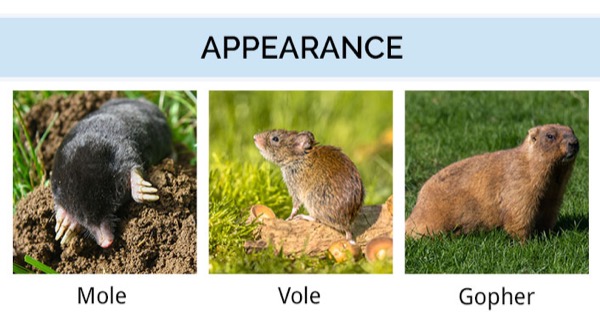
Have you seen a small, furry creature on your property? Do you have tunnels or holes in your yard? Not sure what is destroying your lawn and flower beds? You're not alone.
Moles, voles, and gophers can all cause destruction to lawns. These small animals are often confused for one another but are in fact very different. Identifying which creature you have in your yard will lead you to the correct treatment plan, putting you on the path to a recovering lawn faster.
Read below to learn the difference between moles, voles, and gophers, or select one of the following topics to learn about the unique features of each animal:
Appearance

- Do not have visible eyes
- Have large paddle-like front paws with claws
- Have long snouts
- 6-8 inches long, weigh less than a pound
- Have brown or dark gray fur
Voles (Also known as field mice)
- Have visible eyes
- Are rodents, often confused with gerbils or mice
- Have small ears, tails, legs
- 3-7 inches long, weigh less than a pound
- Have brown or light gray fur
Gophers (Also known as pocket gophers)
- Have visible eyes and teeth
- Large, white front paws with claws
- Flat head and stocky body with small ears
- Have large cheek pouches lined in fur that can extend to the shoulders
- Short, hairy, white tail
- 6-14 inches long, weight up to one pound
- Fur often matches the color of the local soil, can range from dark brown to black, but fur on the stomach is light
Mounds and Tunnels

- Create underground tunnels and burrows
- Tunnels are usually very deep below ground as moles are searching for insects to eat
- May see exit holes and mounds of dirt in yard, mounds are round
- May also see tunnels in yard
- Create runways on the surface of the yard through the grass
- Runways are often less than 2 inches wide
- May also make holes in the yard
- Create mounds that appear as holes in the yard
- The dirt around the holes are fan or kidney bean shaped
- Mounds can be 1-2 feet tall
Damage

- In addition to mounds and tunnels in your turf, moles can disturb other plants with their tunnels
- Tunnels can displace the roots and bulbs of plants, shifting them and possibly causing them to die
- Tunnels can also damage irrigation tubes and utility cables that run below ground
- Voles eat grasses and roots, which in turn will damage plants and turf. Plants and turf can dry out without roots to give them moisture and may fall over without roots to hold them in the ground
- In the cooler months, voles may gnaw on the bark of plants and trees
- Voles can also destroy lawns, both aesthetically and health-wise, with their runways
- Gophers primarily live below ground, but will quickly appear above ground to gather food in their cheeks
- Gophers eat plants, and will eat and damage ornamentals, landscaping, and shrubs
- Gophers may also damage irrigation tubes and utility cables that run below ground when they dig their mounds
How to Control: Trapping and Baiting
Trapping and baiting are the two methods proven to work against moles, voles, and gophers.
Setting traps within tunnels, mounds, and holes will catch animals while baiting poisons the animals who confuse the bait for food. Both steps require testing for live and active mounds as baiting a mound or tunnel that has been abandoned will be a waste of bait.
If you believe you have a mole, vole, or gopher population in your yard and are ready to treat, refer to our animal-specific guides for treatment options.
If you have any questions about identifying moles, voles, or gophers or would like further treatment and prevention advice, please give our team a call at 866-581-7378 or email [email protected].


